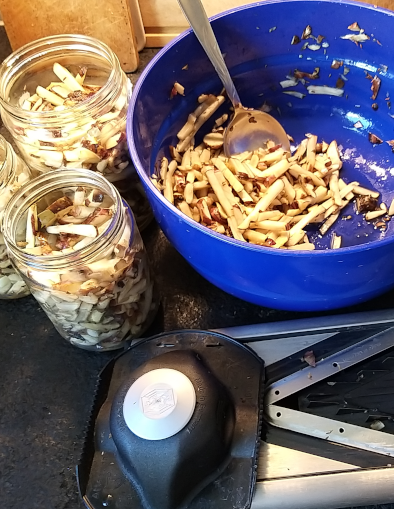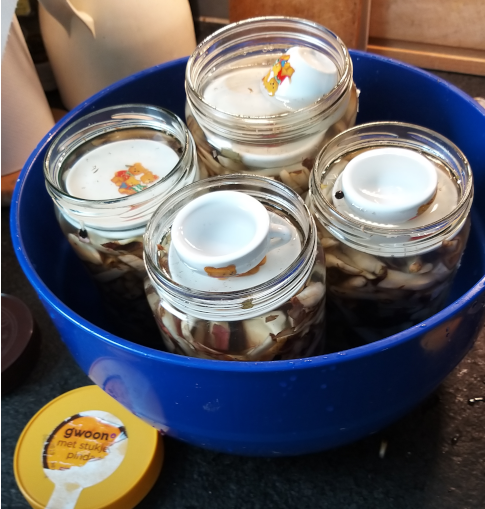This weekend we received 1,5 kg of fresh topinambur from a friend. Topinambur or jerusalem artichoke is related to the sunflower. The tubers overwinter in the ground and can be harvested throughout the winter. They taste delicious, a little nutty and sweet, and are a good source of inulin, which is indigestible to the intestinal flora, but important for gut health. One big disadvantage: they cause flatulence… This can be avoided by a procedure that enhances the health effects even more: ferment them! We tried that last year, and really liked the result, so I set up this whole batch for fermenting, and thought it would be nice to share how to do this.
Ingredients
500 grams of Jerusalem artichoke
8,5 gram salt (1,7%)
Spices to taste, like caraway or mustard seeds, peppercorns, bay leaves
Water with 1.7% salt
If you bought the topinbur in a shop, they are probably already pretty clean and you can just rinse them. If they come straight from a garden, I would soak and rinse them a few times in a bucket (best done outside, to avoid all the mud clogging your sink…), and brush them well.

Cut the topinambur into strips or slices with a mandolin or food processor. Mix with 1.7% salt, herbs and spices and put in a fermenting jar. I like to use big peanut butter jars as you can see in the pictures, but any glass or porcelain jar will do. Fill up with brine until it is covered. When the fermenting starts, the vegetables will float to the top. To avoid this, you can put a clean stone, glass or porcelain weight on top – here I am using the porcelain tea set that my kids outgrew a long time ago! I have also often fermented without weights, then simple push down the veggies back in the brine every 1-2 days with a clean fork. Close the jar with a lid, but if you use metal lids, do not screw close completely, so that gases can still escape. The plastic lids of my peanut butter jars are not fully airtight anyway to I can close them fully. Put the jars on a tray or in a big bowl, as there will be some liquid pushed out of the jar. Check the jars now and then, if the liquid level goes down to much, add a bit more salt water.
When the bubbling has reduced after about 1-2 weeks your fermented topinambur is ready. Simply taste test and if you think it is sour enough, you can put it in the fridge where you can store it for up to a year.
After fermentation, the topinambur remains quite firm and crispy. A couple of tablespoons taste great with a sandwich, but fermented topinambur is also delicious in salads and with all kinds of stews.

